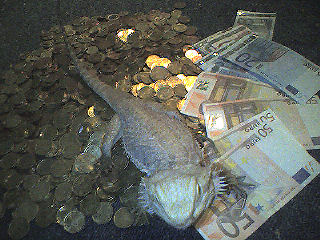Agama - Bearded Dragon
Yellow-headed Bearded Dragon, Inland Bearded Dragon Scientific Name: Pogona vitticeps
Sat, 14th June, 2025 - 7:10 pm GMT
Sponsor Ads:

Alternative Name
Yellow-headed Bearded Dragon, Inland Bearded Dragon Scientific Name: Pogona vitticepsBasic Info
Bearded Dragons are fairly large lizards that grow to about 20 inches (50cm), and have a very wide body. Like many other agamids, they have a triangular, blunt head. The scales on the throat and head are pointed, as are the scales on the sides of the body. When threatened, the Dragon opens its mouth and flares out its throat.
Health
Bearded Dragons should be kept in a large enclosure. One or two adults should be housed in enclosure that is at least 3 to 4 feet in length. Smaller animals, i.e. juveniles or hatchlings, should not be kept with adults, as they may be bullied or eaten. Overcrowding of an enclosure can cause fighting and stress. They should be warm yet well ventilated. The enclosure should be furnished with branches to climb and bask on and caves or other hiding areas. They are messy animals so the enclosure will need to be cleaned often. The temperature of the enclosure should be around 76 - 80 degrees Fahrenheit on the cool side of the tank and the high 80s on the warm side. There should also be a basking area 95 - 100 degrees Fahrenheit. The temperature should drop to the mid 70s at night. Bearded Dragons should be exposed to full spectrum UV light for about 13 hours a day. Bearded Dragons should be provided with fresh water, though they may not drink it often. Light misting should be done occasionally to ensure proper humidity. Some hobbyists suggest misting the plants as opposed to the enclosure. Baby Bearded Dragons, between up to four months should only be fed very small food. Larger food can cause serious problems including paralysis, seizures, gut impaction, or death. They can be fed pinhead crickets and tiny worms, gradually moving to larger animals. Adult animals need a diet of about 20% plants, including vegetables and fruits like squash, green beans, carrots, parsley, dandelion greens, mango, raspberries, and cantaloupe. The remaining 80% of the diet should be meaty items such as insects and pinkie mice. They should be fed three to five times per week, although babies and pregnant females should be fed more. Some individuals may have shed problems due to low humidity levels. This can be avoided by misting the enclosure with water. To avoid spotting of the glass, use distilled water. It has been reported that spraying a Beardie that is currently having shedding problems with warm water may help them finish their shed easily. Breeding Bearded Dragons are sexually mature around two years of age. Mature males darken to black during breeding season. At other times, the males can be distinguished from the females by their preanal and femoral pores. Mature females can lay an average 16 eggs per season, though some may lay considerably more. They lay eggs in the early summer in shallow nests that they dig in the sand. Females may lay infertile eggs in the absence of a male.Habitat
Central AustraliaBehavior
The Bearded Dragon is a type of agamid lizard native to Australia.They are often mistaken for Horned Toads. The Bearded Dragon is quite docile and does not require much handling to become a docile pet. The most common subspecies of the Bearded Dragon is P.vitticeps, also known as the Yellow-Headed Bearded Dragon. Bearded Dragons make their homes in semi-desert regions and open woodlands characterized by arid climates and rocky landscapes. While not arboreal, they are very good climbers and spend a lot of time in bushes and on branches or posts near humans. They enjoy warm temperatures and spend a lot of time on warm mornings and afternoons basking on rocks or branches. Bearded Dragons are diurnal, meaning they are active during the day. They eat both plants and animals, making them omnivores. They will eat almost anything they can catch, including invertebrates and small vertebrates such as mice. They also eat flowers, greens, and fruits. Bearded Dragons like many other animals that live in the desert, spend the hottest hours of the day underground in burrows and venture out again in the evening. Bearded Dragons, when threatened, flatten their bodies and try to make themselves appear broader. They also expose their 'beard,' a flaring of the throat, when threatened. They are social animals, making them entertaining in captivity. They use their tongue to explore their environment and young Beardeds, if they feel safe, will 'wave' to display non-aggression. Bearded Dragons live from 7 to 12 years on average, though some may live as long as 20 if they are well cared for.Origin
AustraliaHistory
The Yellow-headed Bearded Dragon is often found in, and is one of seven different species of Bearded Dragon.Common Foods
They can be fed pinhead crickets and tiny worms, gradually moving to larger animals. Adult animals need a diet of about 20% plants, including vegetables and fruits like squash, green beans, carrots, parsley, dandelion greens, mango, raspberries, and cantaSponsor Ads:
Originality is undetected plagiarism. -- Dean W. R. Inge
Agama - Bearded Dragon
Coded by: BGID® | ALL RIGHTS RESERVED Copyright © 2000-2025
Disclaimer | Privacy | Report Errors / Contact | Credits








 President of the United States of America - Real Estate mogul, Pageant owner and now one of the most controversial men in political history.
President of the United States of America - Real Estate mogul, Pageant owner and now one of the most controversial men in political history.  Global warming has been in and out as the "latest" hot topic for many years. It is, according to modern scientists, the result of man-made industrial pollutants, clearing forested areas, agriculture, etc. But now they are thinking it started way before the Industrial Revolution...
Global warming has been in and out as the "latest" hot topic for many years. It is, according to modern scientists, the result of man-made industrial pollutants, clearing forested areas, agriculture, etc. But now they are thinking it started way before the Industrial Revolution...  Politician, US Vice President and President of the USA - Joseph Robinette Biden Jr.
Politician, US Vice President and President of the USA - Joseph Robinette Biden Jr.  versus
versus  Russia: 'The Evil Empire'? Are they all that bad or is it just the USA trying to portray Russia as bad because they are a world power with land bigger and a society very different from the USA ideal?
Russia: 'The Evil Empire'? Are they all that bad or is it just the USA trying to portray Russia as bad because they are a world power with land bigger and a society very different from the USA ideal? 
 Corona virus
Corona virus 
 Users with wide screen monitors can benefit from more content on every page.
Users with wide screen monitors can benefit from more content on every page.